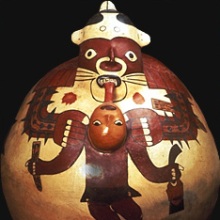learn how
Ancient Techniques - Ceramics - Completion

Decoration could be added after construction. Texturing or carving was done by incising or stamping. Simple brushes made from hair, feathers, or prepared twigs were used for painting with minerals. The pottery was burnished to add a reflective surface. Resist methods were used to create layers of decoration.
The crucial step of firing the work was done quickly and expertly, often without kilns.
Post-fired decoration could include painting with colours unable to withstand high temperatures, such as Maya blue or cinnabar. Figures were occasionally dressed with feathers, textiles, or jewelry.

Texture was achieved by incising or impressing patterns into the soft clay. Fingers or tools were dragged across or poked into the clay surface. Stamps or found objects were used to make repeat patterns.
This very early Valdivia figure, the oldest ceramic in the collection of the Gardiner Museum, shows the effects of scoring soft clay, in order to indicate her hairstyle. This very simply-made figure is distinguished by the care given to its luxuriant tresses.

Some of the most impressive and beautiful pottery was made by painting the clay surface with mineral pigments before firing. Naturally occurring minerals such as iron oxide, copper, and manganese were available locally or through trade.
Hieroglyphic texts, narrative scenes, simple designs and complex abstractions were applied on ceramic surfaces using this method.
Some painters were specialists and painted hieroglyphic texts and figures that allow us to identify them as individuals.

Burnishing or polishing the surface before firing created a smooth reflective surface on the finished piece. To burnish, a partially air-dried vessel or sculpture was painted with a fine clay slip before carefully polishing with a smooth pebble. Burnishing creates a beautiful sheen that reflects light and adds strength to the clay walls of the pot.
This large, shapely female figure from West Mexico, c. 200 B.C. - A.D. 250, is beautifully burnished.

Resist decoration, a technique with a long tradition, was done by keeping a design 'in reserve', protecting it with wax or other materials before painting the surface of the piece or smoke firing it.
This type of decoration resembles batik in method. Often the main design element is carried by the natural colour of the clay while the rest of the surface of the pottery acts as the background, as with this West Mexican figure, c. 200 B.C. - A.D. 250.

Pottery is baked in hot fires, but not always in kilns. Few instances of kilns or purpose-built ovens for the firing of ceramics have been excavated archaeologically or identified in the ancient Americas. Most pottery was fired in open bonfires, sometimes in shallow pits.
Clay baked this way is subject to tremendous stresses and may crack or explode. However, the ceramics that resulted from this type of firing were sometimes delicate, often quite large, and are acknowledged to be some of the most beautiful pottery ever made.

Air-dried pottery was carefully stacked on top of fuel, sometimes in a shallow pit. The pottery was then covered with broken pots to protect it from the wind and a top layer of fuel. Once ignited, additional fuel - dry seaweed, twigs or grasses - was placed on top to quickly increase the speed and efficiency of the firing.
The potter was careful to keep the fire hot and even. Firing was done quickly and well. Even so, many pieces must have been lost to breakage.
Image: Firing pottery in Choquemarca, Peru.

Firing methods affect the finished colour of clay. A fire rich in oxygen will produce bright, clear colours. A smoky, oxygen-starved fire will cause the clay to become gray or black.
The dark, almost metallic burnished surface of this Chimú pot adds to the power of its form.

It is possible that people traded for particular types of rare clay, such as kaolin, fine-grained clay that was used to make a desirable white slip for painting before firing. Mineral deposits useful for colouring clay and for polychrome brush-work may have been important trade goods as well.
The colours derived from different mineral oxides are most apparent after firing. An even, oxygen-rich fire is needed to achieve the clear bright colours seen on this Nasca vessel.

Decorating after firing with organic pigments, often red, black, or blue, was a method used to further embellish pottery vessels and figures. Sometimes, as with this low vessel from Teotihuacan, stucco was used to decorate the surface of a fired pot.
In the Amazon region, pottery still warm from the fire was rubbed with tree resin. This strengthened the walls and made the vessel able to hold water.

Certain colours could hold important cultural meaning. The Maya associated red with the renewal of life and blood; blue indicated the sky and the water of the underworld.
Red was obtained from cinnabar, a mineral that is mined from exposed veins in the earth's surface. The Maya used ground cinnabar to highlight carvings on jade, ceramics, stone and bone.
Blue was elusive and could not withstand the temperatures of the kiln. The Maya blue required a mixture of indigo dye and the mineral attapulgite. The colour of the blue varied.